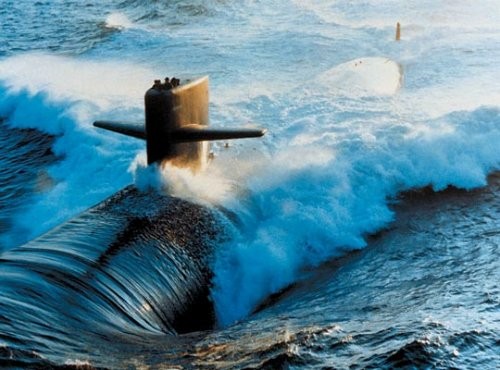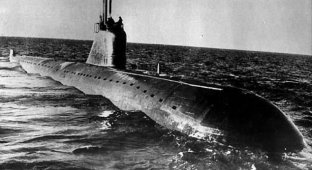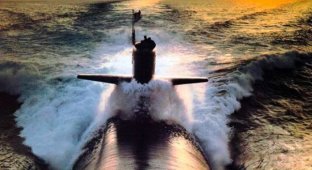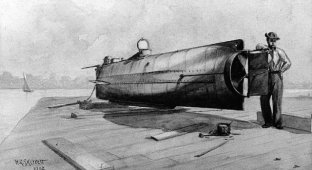How the first nuclear submarines were made in the USSR
For more than half a century, the best design minds of all maritime powers solved a puzzling problem: how to find an engine for submarines that would work both above and under water, and, moreover, did not require air, like a diesel engine or a steam engine. And such an engine, common for the underwater and surface elements, was found. It became a nuclear reactor.

No one knew how a nuclear genie would behave, enclosed in a steel “bottle” of a durable body, compressed by the pressure of depth, but if successful, the benefits of such a solution were too great. And the Americans took a risk. In 1955, fifty-five years after the first American submarine sank, the world's first nuclear-powered ship was launched. It was named after the submarine invented by Jules Verne - the Nautilus.
The Soviet nuclear fleet began in 1952, when intelligence reported to Stalin that the Americans had begun construction of a nuclear submarine. And six years later, the Soviet nuclear submarine K-3 expanded its sides first into the White Sea, then into the Barents Sea, and then into the Atlantic Ocean. Its commander was Captain 1st Rank Leonid Osipenko, and its creator was General Designer Vladimir Nikolaevich Peregudov. In addition to the tactical number, "K-3" also had its own name, not as romantic as the Americans, but in the spirit of the times - "Leninsky Komsomol". “In essence, the Peregudov Design Bureau,” notes the historian of the Soviet submarine fleet, Rear Admiral Nikolai Mormul, “created a fundamentally new ship: from appearance to product range.
Peregudov managed to create a shape for the nuclear-powered icebreaker that was optimal for moving underwater, removing everything that interfered with its complete streamlining.”
True, the K-3 was armed only with torpedoes, and time demanded the same long-range, long-range, but also fundamentally different missile cruisers. Therefore, in 1960 - 1980, the main focus was on missile submarines. And they were not mistaken. First of all, because it was the atomicins - the nomadic underwater missile launch sites - that turned out to be the least vulnerable carriers of nuclear weapons. Whereas underground missile silos were sooner or later detected from space with an accuracy of up to a meter and immediately became targets of the first strike. Realizing this, first the American and then the Soviet Navy began to place missile silos in the durable hulls of submarines.

The nuclear-powered six-missile submarine K-19, launched in 1961, was the first Soviet atomic missile submarine. At its cradle, or rather at its stocks, stood the great academicians: Aleksandrov, Kovalev, Spassky, Korolev. The boat impressed with its unusually high underwater speed, the length of its stay under water, and the comfortable conditions for the crew.
“In NATO,” notes Nikolai Mormul, “there was interstate integration: the United States built only an ocean-going fleet, Great Britain, Belgium, and the Netherlands built anti-submarine ships, the rest specialized in ships for closed theaters of military operations. At this stage of shipbuilding, we were the leaders in many tactical and technical elements. We have put into operation comprehensively automated high-speed and deep-sea combat nuclear submarines, the largest amphibious hovercraft. We were the first to introduce large high-speed anti-submarine ships on controlled hydrofoils, gas turbine power, supersonic cruise missiles, missile and landing ekranoplanes. However, it should be noted that in the budget of the USSR Ministry of Defense the share of the Navy did not exceed 15%, in the United States of America and Great Britain it was two to three times more."
However, according to the official historiographer of the fleet M. Monakov, the combat strength of the USSR Navy by the mid-80s “consisted of 192 nuclear submarines (including 60 strategic missile submarines), 183 diesel submarines, 5 aircraft-carrying cruisers ( including 3 heavy "Kiev" type), 38 cruisers and large anti-submarine ships of the 1st rank, 68 large anti-submarine ships and destroyers, 32 patrol ships of the 2nd rank, more than 1000 ships of the near sea zone and combat boats, over 1600 combat and transport aircraft. The use of these forces was carried out to ensure strategic nuclear deterrence and the national-state interests of the country in the World Ocean."
Russia has never had such a huge and powerful fleet.
During the years of peace—this time has a more precise name: the “Cold War” in the World Ocean—more submariners and submarines died in Russia than in the Russian-Japanese, World War I, civil, and Soviet-Finnish wars combined. It was a real war with rams, explosions, fires, sunken ships and mass graves of dead crews. During its course, we lost 5 nuclear and 6 diesel submarines. The US Navy opposing us is 2 nuclear submarines.
The active phase of the confrontation between the superpowers began in August 1958, when Soviet submarines entered the Mediterranean Sea for the first time. Four "eski" - medium-displacement submarines of type "C" (Project 613) - moored in accordance with an agreement with the Albanian government in the Gulf of Vlora. A year later, there were already 12 of them. Submarine cruisers and fighters circled in the abyss of the World Ocean, tracking each other down. But despite the fact that no great power had such a submarine fleet as the Soviet Union, it was an unequal war. We did not have a single nuclear aircraft carrier and not a single geographically convenient base.
On the Neva and Northern Dvina, in Portsmouth and Groton, on the Volga and Amur, in Charleston and Annapolis, new submarines were born, replenishing the NATO Grand Fleet and the Great Submarine Armada of the USSR. Everything was determined by the excitement of the pursuit of the new mistress of the seas - America, who proclaimed: “Whoever owns the trident of Neptune owns the world.” The car of the third world war was started at idle speed...
The beginning of the 70s was one of the peaks in the oceanic Cold War. The US aggression in Vietnam was in full swing. Submarines of the Pacific Fleet conducted combat tracking of American aircraft carriers cruising in the South China Sea. In the Indian Ocean there was another explosive region - Bangladesh, where Soviet minesweepers neutralized Pakistani mines laid during the Indo-Pakistani military conflict. It was also hot in the Mediterranean Sea. In October, another Arab-Israeli war broke out. The Suez Canal was mined. The ships of the 5th operational squadron escorted Soviet, Bulgarian, East German cargo ships and liners according to all wartime rules, protecting them from terrorist raids, missiles, torpedoes and mines. Each time has its own military logic. And in the logic of confrontation with world maritime powers, an aggressive nuclear missile fleet was a historical inevitability for the USSR. For many years we played nuclear baseball with America, which took the title of mistress of the seas from Britain.
America opened the sad score in this match: on April 10, 1963, the nuclear submarine Thresher sank for an unknown reason at a depth of 2,800 meters in the Atlantic Ocean. Five years later, the tragedy repeated itself 450 miles southwest of the Azores: the US Navy nuclear submarine Scorpio, along with 99 sailors, remained forever at a depth of three kilometers. In 1968, the French submarine Minerve, the Israeli submarine Dakar, and our diesel missile boat K-129 sank in the Mediterranean Sea for unknown reasons. There were also nuclear torpedoes on board. Despite the depth of 4 thousand meters, the Americans managed to raise the first two compartments of this broken submarine. But instead of secret documents, they encountered problems with the burial of the remains of Soviet sailors and nuclear torpedoes lying in the bow apparatus.
We equalized the number of lost atomic submarines with the Americans at the beginning of October 1986. Then, 1,000 kilometers northeast of Bermuda, fuel exploded in the missile compartment of the submarine cruiser K-219. There was a fire. 20-year-old sailor Sergei Preminin managed to shut down both reactors, but he himself died. The superboat remained in the depths of the Atlantic.

On April 8, 1970, in the Bay of Biscay, after a fire at great depths, the first Soviet nuclear powered ship, K-8, sank, taking with it 52 lives and two nuclear reactors.
On April 7, 1989, the atomic ship K-278, better known as Komsomolets, sank in the Norwegian Sea. When the bow of the ship sank, an explosion occurred, practically destroying the hull of the boat and damaging the combat torpedoes with an atomic charge. 42 people died in this tragedy. "K-278" was a unique submarine. It was from here that the construction of the deep-sea fleet of the 21st century was supposed to begin. The titanium hull allowed it to dive and operate at a depth of a kilometer - that is, three times deeper than all other submarines in the world...

The camp of submariners was divided into two camps: some blamed the crew and high command for the misfortune, others saw the root of evil in the low quality of marine equipment and the monopoly of the Ministry of Shipbuilding Industry. This split caused a furious debate in the press, and the country finally learned that this was our third nuclear submarine that had sunk. Newspapers began vying with each other to name the names of ships and numbers of submarines that died in “peacetime” - the battleship Novorossiysk, the large anti-submarine ship Brave, the submarines S-80 and K-129, S-178. and "B-37"... And, finally, the last victim - the nuclear-powered icebreaker "Kursk".

...We did not win the Cold War, but we forced the world to reckon with the presence of our submarines and our cruisers in the Atlantic, Mediterranean, Pacific and Indian Oceans.
In the 60s, nuclear submarines firmly established themselves in the combat formations of the American, Soviet, British and French fleets. Having given the submarines a new type of engine, the designers equipped the submarines with new weapons - missiles. Now nuclear missile submarines (the Americans called them “boomers” or “citykillers”; we called them strategic submarines) began to threaten not only world shipping, but the entire world as a whole.
The figurative concept of “arms race” took on a literal meaning when it came to such precise parameters as, for example, speed underwater. The underwater speed record (still unsurpassed by anyone) was set by our submarine K-162 in 1969. “We dived,” recalls test participant Rear Admiral Nikolai Mormul, “we chose an average depth of 100 meters. We set off. As the speed increased, everyone felt that the boat was moving with acceleration. After all, you usually notice movement under water only by the lag readings. But here, as in an electric train, everyone was led back. We heard the noise of the water flowing around the boat. It increased along with the speed of the ship, and, when we exceeded 35 knots (65 km/h), the roar of the plane was already in our ears. According to our estimates, the noise level reached up to 100 decibels. Finally, we reached a record speed of forty-two knots! Not a single manned “underwater projectile” yet did not cut the sea strata so rapidly."
A new record was set by the Soviet submarine Komsomolets five years before its sinking. On August 5, 1984, she made a dive of 1,000 meters, unprecedented in the history of world military navigation.
In March last year, the 30th anniversary of the nuclear submarine flotilla was celebrated in the Northern Fleet village of Gadzhievo. It was here, in the remote Lapland bays, that the most complex technology in the history of civilization was mastered: nuclear-powered underwater rocket launchers. It was here, in Gadzhievo, that the first cosmonaut of the planet came to the pioneers of hydrospace. Here, on board the K-149, Yuri Gagarin honestly admitted: “Your ships are more complex than space ships!” And the god of rocketry, Sergei Korolev, who was asked to create a rocket for an underwater launch, uttered another significant phrase: “An underwater rocket is absurd. But that’s why I’ll undertake to do it.”
And he did... Korolev would have known that one day, launching from under water, boat rockets will not only cover intercontinental distances, but also launch artificial Earth satellites into space. This was first accomplished by the crew of the Gadzhievsky submarine cruiser "K-407" under the command of Captain 1st Rank Alexander Moiseev. On July 7, 1998, a new page was opened in the history of space exploration: an artificial Earth satellite was launched from the depths of the Barents Sea into low-Earth orbit by a standard ship rocket...
And a new type of engine - a single, oxygen-free and rarely (once every few years) replenished with fuel - allowed humanity to penetrate into the last hitherto inaccessible region of the planet - under the ice dome of the Arctic. In the last years of the 20th century, people started talking about the fact that nuclear submarines are an excellent trans-Arctic vehicle. The shortest route from the Western Hemisphere to the Eastern Hemisphere lies under the ice of the Northern Ocean. But if atomic ships are re-equipped into underwater tankers, bulk carriers and even cruise ships, then a new era will open in world shipping. In the meantime, the very first ship of the Russian fleet in the 21st century was the nuclear submarine Gepard. In January 2001, the St. Andrew's flag, covered with centuries-old glory, was raised on it.
























